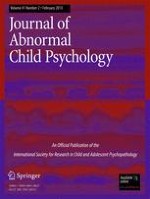01-02-2013
Etiological Contributions to the Covariation Between Children’s Perceptions of Inter-Parental Conflict and Child Behavioral Problems
Gepubliceerd in: Research on Child and Adolescent Psychopathology | Uitgave 2/2013
Log in om toegang te krijgenAbstract
Prior work has suggested that inter-parental conflict likely plays an etiological role in child behavior problems. However, family-level measurement of inter-parental conflict in most traditional child twin studies has made it difficult to tease apart the specific causal mechanisms underlying this association. The Children’s Perception of Inter-parental Conflict scale (CPIC) provides a child-specific measurement tool for examining these questions, as its subscales tap multiple dimensions of conflict assessed from the child’s (rather than the parent’s) perspective. The current study examined (1) the degree of genetic and environmental influence on each of the CPIC subscales, and (2) etiological contributions to the covariation between the CPIC scales and parental reports of child behavioral problems. The CPIC was completed by 1,200 child twins (aged 6–11 years) from the Michigan State University Twin Registry (MSUTR). Parents completed the Child Behavior Checklist (CBCL) to assess child internalizing and externalizing behavior problems. Multivariate models were examined to evaluate the relative contributions of genetic and environmental factors to both the CPIC scales and to their overlap with child behavioral outcomes. Modeling results indicated no significant moderation of sex or age. Significant environmental overlap emerged between the CPIC conflict properties scale and child internalizing and externalizing problems. By contrast, significant genetic correlations emerged between the CPIC self-blame scale and externalizing problems as well as between the CPIC threat scale and internalizing problems. Overall, findings suggest that the subscales of the CPIC are somewhat etiologically diverse and may provide a useful tool for future investigations of possible gene-environment interplay.
